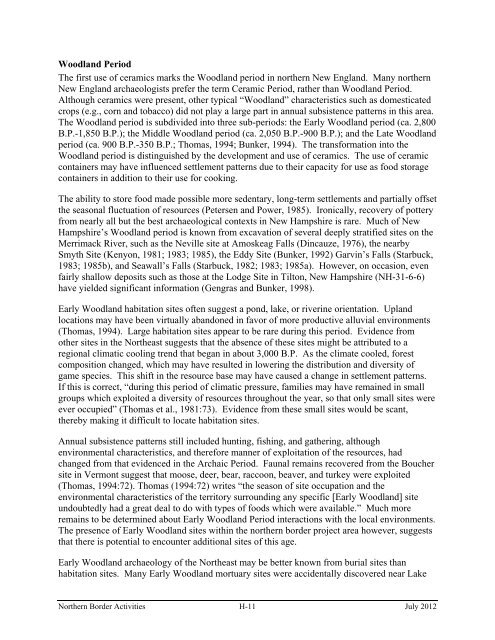Appendix H - Historical Archaeological and ... - CBP.gov
Appendix H - Historical Archaeological and ... - CBP.gov
Appendix H - Historical Archaeological and ... - CBP.gov
Create successful ePaper yourself
Turn your PDF publications into a flip-book with our unique Google optimized e-Paper software.
Woodl<strong>and</strong> Period<br />
The first use of ceramics marks the Woodl<strong>and</strong> period in northern New Engl<strong>and</strong>. Many northern<br />
New Engl<strong>and</strong> archaeologists prefer the term Ceramic Period, rather than Woodl<strong>and</strong> Period.<br />
Although ceramics were present, other typical “Woodl<strong>and</strong>” characteristics such as domesticated<br />
crops (e.g., corn <strong>and</strong> tobacco) did not play a large part in annual subsistence patterns in this area.<br />
The Woodl<strong>and</strong> period is subdivided into three sub-periods: the Early Woodl<strong>and</strong> period (ca. 2,800<br />
B.P.-1,850 B.P.); the Middle Woodl<strong>and</strong> period (ca. 2,050 B.P.-900 B.P.); <strong>and</strong> the Late Woodl<strong>and</strong><br />
period (ca. 900 B.P.-350 B.P.; Thomas, 1994; Bunker, 1994). The transformation into the<br />
Woodl<strong>and</strong> period is distinguished by the development <strong>and</strong> use of ceramics. The use of ceramic<br />
containers may have influenced settlement patterns due to their capacity for use as food storage<br />
containers in addition to their use for cooking.<br />
The ability to store food made possible more sedentary, long-term settlements <strong>and</strong> partially offset<br />
the seasonal fluctuation of resources (Petersen <strong>and</strong> Power, 1985). Ironically, recovery of pottery<br />
from nearly all but the best archaeological contexts in New Hampshire is rare. Much of New<br />
Hampshire’s Woodl<strong>and</strong> period is known from excavation of several deeply stratified sites on the<br />
Merrimack River, such as the Neville site at Amoskeag Falls (Dincauze, 1976), the nearby<br />
Smyth Site (Kenyon, 1981; 1983; 1985), the Eddy Site (Bunker, 1992) Garvin’s Falls (Starbuck,<br />
1983; 1985b), <strong>and</strong> Seawall’s Falls (Starbuck, 1982; 1983; 1985a). However, on occasion, even<br />
fairly shallow deposits such as those at the Lodge Site in Tilton, New Hampshire (NH-31-6-6)<br />
have yielded significant information (Gengras <strong>and</strong> Bunker, 1998).<br />
Early Woodl<strong>and</strong> habitation sites often suggest a pond, lake, or riverine orientation. Upl<strong>and</strong><br />
locations may have been virtually ab<strong>and</strong>oned in favor of more productive alluvial environments<br />
(Thomas, 1994). Large habitation sites appear to be rare during this period. Evidence from<br />
other sites in the Northeast suggests that the absence of these sites might be attributed to a<br />
regional climatic cooling trend that began in about 3,000 B.P. As the climate cooled, forest<br />
composition changed, which may have resulted in lowering the distribution <strong>and</strong> diversity of<br />
game species. This shift in the resource base may have caused a change in settlement patterns.<br />
If this is correct, “during this period of climatic pressure, families may have remained in small<br />
groups which exploited a diversity of resources throughout the year, so that only small sites were<br />
ever occupied” (Thomas et al., 1981:73). Evidence from these small sites would be scant,<br />
thereby making it difficult to locate habitation sites.<br />
Annual subsistence patterns still included hunting, fishing, <strong>and</strong> gathering, although<br />
environmental characteristics, <strong>and</strong> therefore manner of exploitation of the resources, had<br />
changed from that evidenced in the Archaic Period. Faunal remains recovered from the Boucher<br />
site in Vermont suggest that moose, deer, bear, raccoon, beaver, <strong>and</strong> turkey were exploited<br />
(Thomas, 1994:72). Thomas (1994:72) writes “the season of site occupation <strong>and</strong> the<br />
environmental characteristics of the territory surrounding any specific [Early Woodl<strong>and</strong>] site<br />
undoubtedly had a great deal to do with types of foods which were available.” Much more<br />
remains to be determined about Early Woodl<strong>and</strong> Period interactions with the local environments.<br />
The presence of Early Woodl<strong>and</strong> sites within the northern border project area however, suggests<br />
that there is potential to encounter additional sites of this age.<br />
Early Woodl<strong>and</strong> archaeology of the Northeast may be better known from burial sites than<br />
habitation sites. Many Early Woodl<strong>and</strong> mortuary sites were accidentally discovered near Lake<br />
Northern Border Activities H-11 July 2012
















